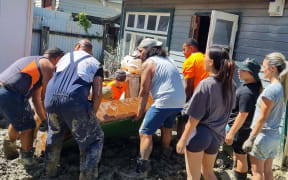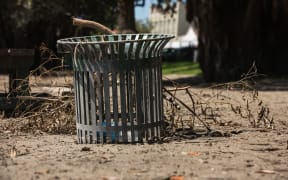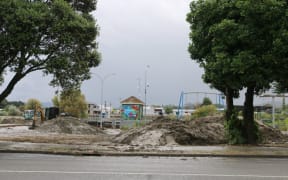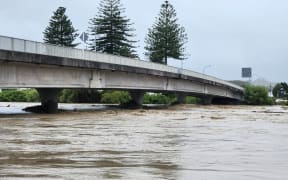
The banks of the Wairoa River, which runs through the town, remain covered in nearly a metre of silt three months after the cyclone. Photo: RNZ / Kate Green
Families are still displaced and hundreds of homes unliveable in Wairoa, three months after Cyclone Gabrielle.
State Highway 2 from Gisborne to Wairoa is open, with a handful of speed restricted areas.
South of Wairoa towards Napier, the highway has been closed since the storm, thanks to the failure of the bridge at Waikare Gorge.
According to Waka Kotahi, the road will be open by 14 May, with a new bailey bridge across the gorge and more than 100 areas of damage along the route under repair.
It has been a long three months.
Mayor Craig Little said patients needing treatment at Napier Hospital were being flown down, and were not allowed to take support people with them.
Businesses, too, were feeling the pinch, with many forced to change shipping and supply routes, often at an inflated cost.
Residential areas north of the river were hit hard by flooding the day after the downpour, as water cascaded over the banks of the Wairoa River and raced across the showgrounds and through their homes.
Waihirere Road resident Denise Eaglesome-Karekare still had a thick layer of silt under her home, and said it was proving to be the ultimate sticking point.

Denise Eaglesome-Karekare's home north of the river remains damp, thanks to a layer of silt underneath. Photo: RNZ / Kate Green
"I'm not allowed to actually engage anyone to do any work until I have a [moisture] reading of 16 percent and under. While the silt is sitting under your home, it's keeping your home damp."
The pipes for her septic tank, water, and gas were all underneath that layer of silt, too.
Eaglesome-Karekare said she just wanted to get cracking, but she was being held up waiting for insurance. She was reluctant to go ahead in case she ended up out of pocket.
Part of an email from her insurance company read: "You are welcome to engage your own contractor to remove the silt from under and around your house. We just want to ensure you are aware of the possibility of there being a shortfall if the settlement is based on valuation, and not the remediation cost as per how the EQC Act instructs us to settle the claim."
Eaglesome-Karekare read the paragraph aloud before putting her phone down with a thump on the table.
"So they take the lesser. And [the insurance company] basically told me 'be aware, that's basically what's going to happen'."
She was one of the fortunate few with a builder ready to go - a family friend who was just waiting to get started. But he could not wait forever.
"If I don't hurry up and get them to approve my scope of works, I'm going to lose my builder, and they're like hens' teeth in Wairoa. He is being approached continuously by people who need him to do their houses."
Those who were not insured had been able to move quicker.
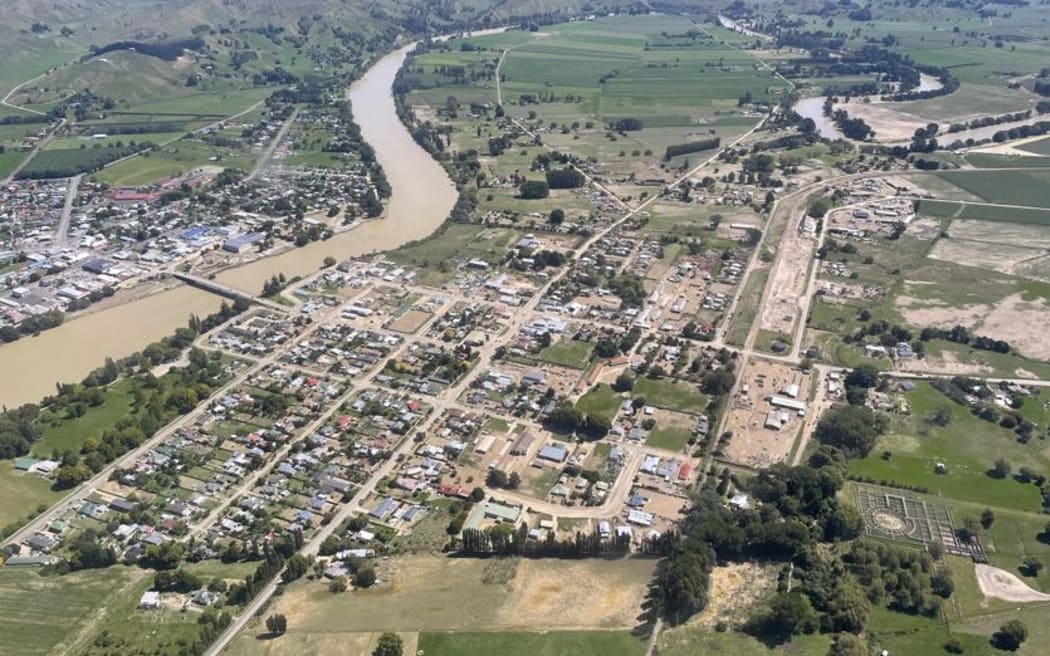
Wairoa from above, seen from a Civil Defence flyover of areas near Gisborne, as experts assessed the damage from Cyclone Gabrielle, on 18 February. Photo: RNZ/ Kate Green
Residents in the next street over said their neighbours were stymied by their insurance companies, but their own home had been silt-free for weeks, and internal moisture levels were already back within healthy limits.
Nearby, Maui and Camelia, now 21, had been together since they were 15, and Maui had lived in his house his entire life.
In the shed, they were up to their elbows in damaged belongings, and they said they had both left their jobs at the meatworks to sort it all out.
For Maui, the reality was starting to hit home.
"The recovery is the hardest, aye? Recovering from the tragedy, and from the aftermath of what it's done to us. That's what's the hardest for me."
As they stood in their driveway chatting, part of the shed wall crashed to the ground.
Benita Tahuri, the town's newly appointed recovery manager, said she was concerned Wairoa would slip quietly out of the headlines.
"Wairoa has had the most damage by percentage per population across Aotearoa," she said.
"I believe the scale of devastation here is still not fully understood, we haven't even come to the worst of the impact.
"We're coming into winter, so we can feel the anxiety of families now starting to say, 'I'm not waiting for insurance, I can't wait for the insurance, I need to do it myself'."
Tahuri was worried people would end up badly out of pocket, or worse, living in damp, unhealthy homes come winter.
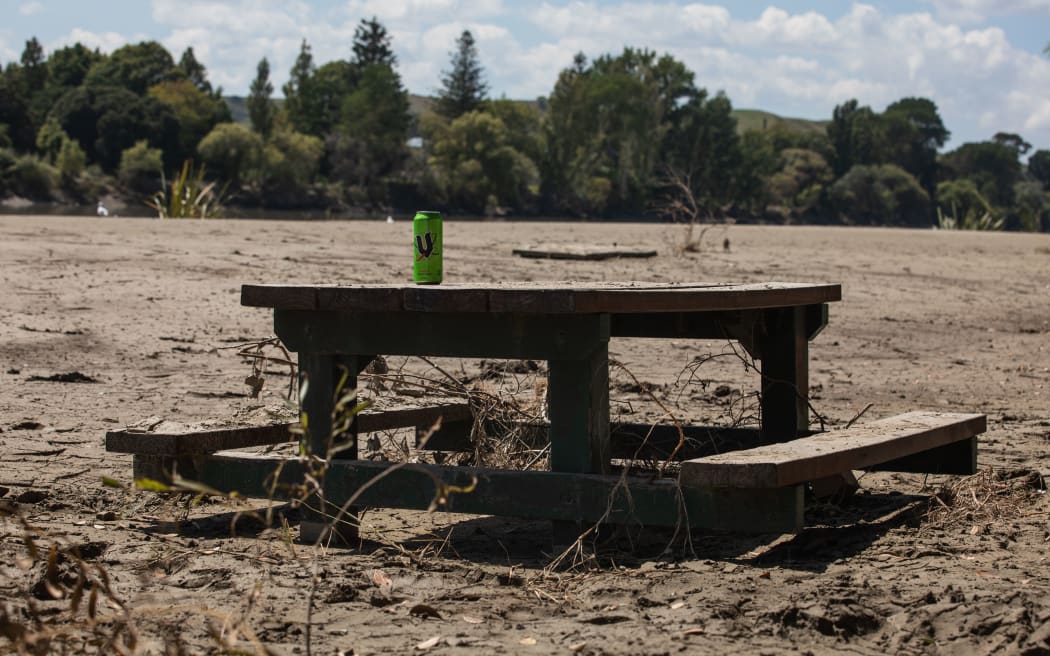
Wairoa was the most damaged town in Cyclone Gabrielle, its recovery manager said. Photo: RNZ / Samuel Rillstone
And there was another problem - the town's limited workforce.
"It's good intentions for people to say, 'get a crew of people together and do some work,' well it's not that easy. Every day I'm getting people saying you should do this, could do that, and we just want help to get it done."
Mayor Little said the downside to getting stuck in and tidying up quickly was that when the money started to come in, they were at the bottom of the list.
In the past few weeks, funding had started to roll in - but Little said Wairoa had barely seen any of it.
"Some magnificent funding comes in, and we get the little bit out the bottom."
He said funding needed to be divvied up according to how many people had been affected in each area, not by total population. It resulted in the bulk of the funding going to Hawke's Bay.
On top of that, news company Stuff had raised more than $4.4 million, but Little said Wairoa received only $30,000. He said they had not seen any of the Lotto money yet, either.
He said council estimated the bill was well into the hundreds of millions.
The government announced more than $130 million for silt removal across Hawke's Bay last week.
But Wairoa District Council had already removed so much of its silt in an attempt to get those who were not insured back into their homes.
Would they be compensated? Little was not sure.
Reason for flooding needs to be pinpointed
To make matters worse, there was still no clear picture of what went wrong that day.
Residents woke up on Tuesday morning thanking their lucky stars they had escaped the worst, Little said.
By midday, the floodwater had roared through their homes and receded.
"We flooded in low-tide," he said. "I believe slash was a big part of it, but I don't know. So let's find out - but let's not wait until six months down the track when all the evidence is gone."
A letter to the Hawke's Bay Regional Council asking for an in-depth inquiry into Cyclone Gabrielle and its impact on the town, which Little sent in March, remained unanswered.
Little said conversations about which areas were safe to rebuild should not happen until the cause of the problem was pinpointed.
Resilience in future storms remained a big priority. Without State Highway 2, Wairoa was cut off. There were no boat landing spots, an airport which only accommodated small planes, and one bridge across the Wairoa River.
So while families dug their homes out of the silt, the council faced the task of retrofitting resilience for the next storm.

